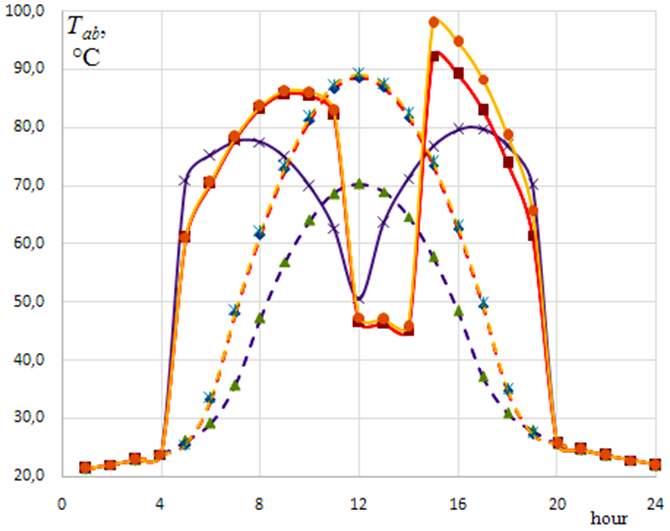Investigation of orientation impact on electrical power of bifacial solar elements
DOI:
https://doi.org/10.20998/2074-272X.2021.3.10Keywords:
bifacial solar photo panels, irradiation of solar panels, orientation of solar cells, power generationAbstract
Purpose. To develop the integrated mathematical model for definition of bifacial solar element rational power operation in the various operation conditions caused by orientation of solar panels and power influence. Methodology. We have proposed the method of definition of bifacial solar elements irradiation and temperature mode and also electric power production at various orientation of panels. Results. We have made analytical investigations of temperature operation conditions of solar elements and their influence on electrical power for various panels orientation in space. Features of irradiation of the forward and back parts of solar panels, conditions of a temperature operating mode and its influence on electric power production are shown. Possibilities of rational conditions of spatial panels orientation are considered. Originality. We have suggested and proved the model of definition bifacial irradiation solar panels and thermal conditions of electric power production and also rational conditions of spatial orientation of panels. Practical value. The developed by us methodology as well as results of its application, allows to choose rational architecture of a solar power station with high efficiency.
References
Gu W., Ma T., Ahmed S., Zhang Y., Peng J. A comprehensive review and outlook of bifacial photovoltaic (bPV) technology. Energy Conversion and Management, 2020, vol. 223, art. no. 113283. doi: https://doi.org/10.1016/j.enconman.2020.113283.
Guerrero-Lemus R., Vega R., Kim T., Kimm A., Shephard L.E. Bifacial solar photovoltaics – A technology review. Renewable and Sustainable Energy Reviews, 2016, vol. 60, рp. 1533-1549. doi: https://doi.org/10.1016/j.rser.2016.03.041.
Tina G.M., Scavo F.B., Gagliano A. Multilayer thermal model for evaluating the performances of monofacial and bifacial photovoltaic modules. IEEE Journal of Photovoltaics, 2020, vol. 10, no. 4, pp. 1035-1043. doi: https://doi.org/10.1109/jphotov.2020.2982117.
Zhang Z., Wu M., Lu Y., Xu C., Wang L., Hu Y., Zhang F. The mathematical and experimental analysis on the steady-state operating temperature of bifacial photovoltaic modules. Renewable Energy, 2020, vol. 155, pp. 658-668. doi: https://doi.org/10.1016/j.renene.2020.03.121.
Jaszczur M., Hassan Q., Teneta J., Majewska E., Zych M. An analysis of temperature distribution in solar photovoltaic module under various environmental conditions. MATEC Web of Conferences, 2018, 11th International Conference on Computational Heat, Mass and Momentum Transfer (ICCHMT 2018), vol. 240, art. no. 04004. doi: https://doi.org/10.1051/matecconf/201824004004.
Bryan J.L., Silverman T.J., Deceglie M.G., Holman Z.C. Thermal model to quantify the impact of sub-bandgap reflectance on operating temperature of fielded PV modules. Solar Energy, 2021, vol. 220, pp. 246-250. doi: https://doi.org/10.1016/j.solener.2021.03.045.
Zhou J., Zhang Z., Ke H. PV module temperature distribution with a novel segmented solar cell absorbance model. Renewable Energy, 2019, vol. 134, pp. 1071-1080. doi: https://doi.org/10.1016/j.renene.2018.09.014.
Wu S.-Y., Guo H.-T., Xiao L., Chen Z.-L. Experimental investigation on thermal characteristics and output performance of PV panel under linear light source and windy conditions. Sustainable Energy Technologies and Assessments, 2021, vol. 43, art. no. 100918. doi: https://doi.org/10.1016/j.seta.2020.100918.
Ruzaimi A., Shafie S., Hassan W.Z.W., Azis N., Effendy Ya'acob M., Elianddy E. Temperature distribution analysis of monocrystalline photovoltaic-thermoelectric generator (PV-TEG) hybrid application. Indonesian Journal of Electrical Engineering and Computer Science, 2020, vol. 17, no. 2, pp. 858-876. doi: http://doi.org/10.11591/ijeecs.v17.i2.pp858-867.
Wysochin V.V. Mathematical model of a solar-plant system with the seasonal heat accumulator. Proceedings of Odessa Polytechnic University, 2011, iss. 2(36), pp. 125-129. (Rus). Available at: https://pratsi.opu.ua/articles/show/695 (accessed 21 June 2020).
Gong Y., Wang Z., Lai Z., Jiang M. TVACPSO-assisted analysis of the effects of temperature and irradiance on the PV module performances. Energy, 2021, vol. 227, art. no. 120390. doi: https://doi.org/10.1016/j.energy.2021.120390.
Wysochin V., Verstak N. Efficiency of use of a hybrid solar collector. Proceedings of Odessa Polytechnic University, 2018, iss. 2(55), pp. 66-71. doi: https://doi.org/10.15276/opu.2.55.2018.07.
Pan A.C., Del Canizo C., Luque A. Effect of thickness on bifacial silicon solar cells. 2007 Spanish Conference on Electron Devices, 2007, pp. 234-237. doi: https://doi.org/10.1109/sced.2007.384035.

Downloads
Published
How to Cite
Issue
Section
License
Copyright (c) 2021 V. V. Wysochin, V. R. Nikulshin, A. E. Denysova

This work is licensed under a Creative Commons Attribution-NonCommercial 4.0 International License.
Authors who publish with this journal agree to the following terms:
1. Authors retain copyright and grant the journal right of first publication with the work simultaneously licensed under a Creative Commons Attribution License that allows others to share the work with an acknowledgement of the work's authorship and initial publication in this journal.
2. Authors are able to enter into separate, additional contractual arrangements for the non-exclusive distribution of the journal's published version of the work (e.g., post it to an institutional repository or publish it in a book), with an acknowledgement of its initial publication in this journal.
3. Authors are permitted and encouraged to post their work online (e.g., in institutional repositories or on their website) prior to and during the submission process, as it can lead to productive exchanges, as well as earlier and greater citation of published work.




